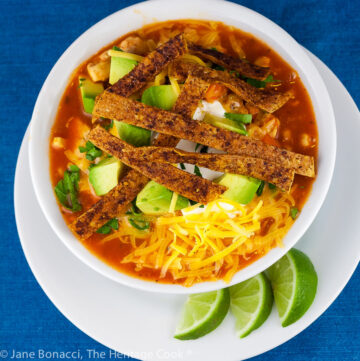After a lovely dinner last week, The Artist asked an interesting question. He wanted to know what the difference was between Creme Brulee (krehm broolay), Pot de Creme (poh duh krehm), and Creme Caramel or Flan (flahn). It led to a discussion that I thought some of you might appreciate. And in case you were wondering, The Artist’s questions often give me ideas for my posts – he is a constant source of inspiration!
All of these desserts are a form of custard or pudding, varying in richness and consistency. Cream gives you the rich mouthfeel and eggs determine how thick it becomes as you cook it. They are most often flavored simply with vanilla or chocolate, but you can infuse the cream with a variety of herbs, spices or other ingredients.
All of them share similar mixing and baking techniques, but the proportions of ingredients and manner of serving them make the difference. Because there are so few ingredients, you must use only the freshest eggs and milk. Anything less and your custards will cook unevenly and may have an off-flavor.
Anytime you cook with eggs there will be a portion that coagulates more than the rest, sort of like scrambled eggs. To remove these tiny pieces and leave you with a smooth and creamy custard, you always pass it through a wire sieve.

Sugar dissolving and being cooked into caramel
Creme Brulee is on nearly every restaurant menu across the country, but few make them well and Flan fares even worse. They are often tough and rubbery which is a result of overcooking the eggs. Sometimes this is just a matter of cooking them too long, but can also be from cooking them without the water bath to protect them. Creme Brulee is the richest of the bunch and is topped with a light sprinkling of sugar which is then torched or broiled until melted and lightly caramelized. Once cooled it becomes a brittle coating that you break through to reach the cool, creamy custard beneath.
Pot de Creme, French for “pot of cream,” just like the other types of custard, is cooked and served in ramekins set in a water bath. The water acts as an insulator, protecting the egg mixture from the external heat source giving the center a chance to cook at the same rate as the outside. Because of the high percentage of egg yolks in the mixture it remains soft and smooth. They are served in the same container you baked them in or if you use a large container, you can spoon it into individual serving containers.

Brushing the sides of the pan of caramel with a wet pastry brush reduces sugar crystals
Creme Caramel is the lightest version, made with whole eggs in addition to egg yolks and milk along with the cream. You make a caramel sauce and place that in the bottom of the baking dishes, then pour the custard over the top. The egg whites act as binders giving this custard enough structure to stand on its own. Egg whites cook more quickly because their proteins coagulate at a lower temperature than the yolks, so this doesn’t take as long to bake. When they are done you invert them onto serving plates, allowing the caramel to pool around the custards. The Mexican or Spanish version of this is called Flan.
All of these require refrigeration due to the eggs and cream. When they have cooled slightly, pierce a piece of plastic wrap in about a dozen places and set it over the top of the custard. Press it down so it touches the surface which prevents a skin from forming. Then place them in the refrigerator.
All custards are best within a day of baking, but you can keep them for a few days in the refrigerator. They are meant to be eaten cool, so don’t leave them out at room temperature for long before serving.
All right, class is dismissed for today. It is time to start eating these wonderful cups of pure delight. Have a terrific Wednesday everyone!


- 1-1/4 cups granulated sugar
- 1/4 cup water
- 1-3/4 cups heavy whipping cream, divided
- 1/2 cup whole milk
- 6 large egg yolks
- Position rack in center of oven and preheat to 325°F. Place 6 (2/3 cups) soufflé dishes or 3/4 cup custard cups/ramekins in large roasting pan.
- Combine sugar and water in a heavy large saucepan, preferably with a light colored interior. Stir over low heat until sugar dissolves. Increase heat and boil without stirring until it reaches a deep amber color, occasionally brushing down the sides of the pan with a wet pastry brush and swirling pan, about 6 minutes.
- Gradually whisk in 1-1/2 cups of the cream (reserve remaining 1/4 cup) and the milk. Be careful because mixture will bubble up furiously. Stir until caramel dissolves, about 2 minutes or until smooth.
- Beat the egg yolks in a large bowl until foamy. Gradually whisk in the warm caramel. Strain through a wire whisk into a 4-cup glass measuring cup with a spout. Slowly pour into dishes in roasting pan, being careful not to generate too many bubbles.
- Pour enough hot water into pan to come halfway up the sides of the dishes. Cover pan with foil. Bake until custard is just set at edges but still moves in center when shaken gently, about 1 hour. Remove from water, cool on rack. Chill until cold, at least 2 hours. (Can be made 2 days ahead. Cover; keep chilled.)
- Beat the remaining 1/4 cup heavy cream in a small bowl until soft peaks form. Add a sprinkling of powdered sugar if desired. Spoon cream into a pastry bag fitted with a large star tip. Pipe 1 rosette in center of each custard. Serve chilled.
Thank You!








Katrina
We made some of these for TWD a while back. What will you do with those egg whites? 😉